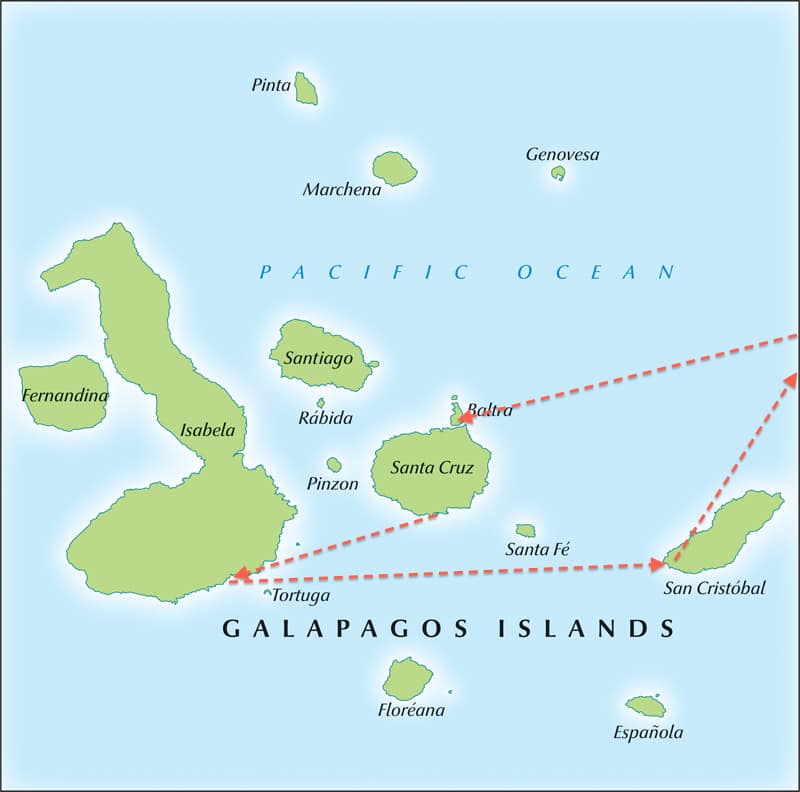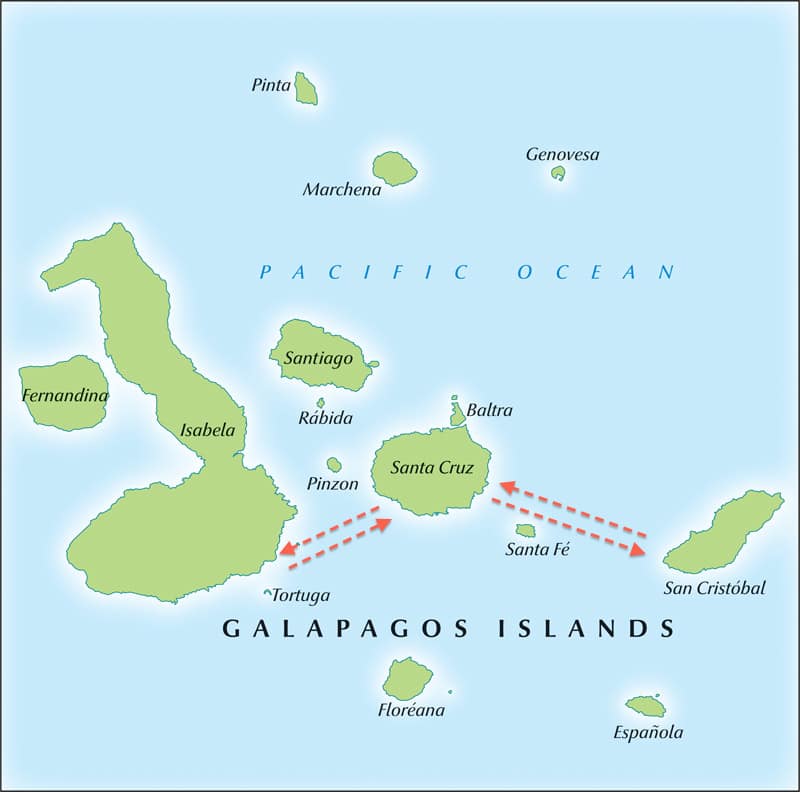We thought twice about writing this post. The Galápagos were once an exclusive destination, but are now teetering on the precipice of mass tourism. We wondered if posts like this were contributing to the devolution of this once-secluded paradise. But, as we said in Eco-friendly tourism in The Galápagos, independent travel to the area is arguably more eco-friendly than visiting on a 100-strong cruise ship. If you’ve always wanted to visit, consider doing it yourself. Not only will you have more flexibility, you won’t have to spend several thousand pounds on your visit. Here’s how we saw The Galápagos on a budget and how you can too.
1. Stick to the inhabited islands
There’s a certain allure to visiting the uninhabited islands – a sort-of Isla-Nublar-Jurassic-Park charm – but doing so is only possible as part of a cruise (i.e. super expensive) and is also one of the more damaging aspects of tourism to the area. The inhabited islands offer almost all the wildlife endemic to the area with the added benefit of leaving the uninhabited islands as free of human presence as possible.
Here’s where you can see the area’s famous animals.
Blue-footed boobies
Inhabited: Las Tintoreras (Isabela), Punta Pitt (San Cristóbal)
Uninhabited: North Seymour, Española, Genovesa
Frigatebirds
Inhabited: Punta Pitt (San Cristóbal), diving by North Seymour (from Santa Cruz)
Uninhabited: North Seymour, Española
Penguins
Inhabited: Las Tintoreras (Isabela), Floreana
Uninhabited: Bartolomé, Fernandina
Giant tortoises
Inhabited: Charles Darwin Station (Santa Cruz), breeding centers on Isabela and San Cristóbal
Uninhabited: Española, Pinzon
Green sea turtles
Inhabited: Tortuga Bay (Santa Cruz), diving by North Seymour (from Santa Cruz)
Uninhabited: Bartolomé, Gardner Bay (Española)
Iguanas
Inhabited: Marine iguanas on all major islands; land iguanas at Charles Darwin Station (Santa Cruz)
Uninhabited: Marine iguanas on all major islands; land iguanas at North Seymour, South Plaza, Santa Fé
Sea lions
Inhabited: All major islands, particularly La Isla de los Lobos (San Cristóbal), South Plaza, La Lobería (San Cristóbal)
Uninhabited: All major islands, particularly Champion
Sharks
Inhabited: Diving by North Seymour (from Santa Cruz), Leon Dormido (San Cristóbal)
Uninhabited: Bartolomé
Waved albatross
Inhabited: Not possible
Uninhabited: Exclusively found on Española from April to November
2. Use public ferries to travel between the islands
It’s certainly not luxurious and its lively waters are enough to stir the sturdiest of stomachs, but public ferry is the cheapest way to travel between the islands. As you can see from the list above, visiting the main islands of Santa Cruz, Isabela and San Cristóbal will allow you to see most of the area’s wildlife.
You can catch a ferry between Santa Cruz and the other two islands. Tickets cost $30 per person each way, and can be bought from reputable travel agencies along the main streets. Just avoid Galápagos Mockingbird on Santa Cruz as they have proven unreliable!
| From | To | Departure Time | Arrival Time |
| Santa Cruz | San Cristobal | 07:00 | 09:15 |
| Santa Cruz | San Cristobal | 14:00 | 16:30 |
| Santa Cruz | Isabela | 07:00 | 09:30 |
| Santa Cruz | Isabela | 14:00 | 16:15-16.30 |
| Isabela | Santa Cruz | 06:00 | 08:00 |
| Isabela | Santa Cruz | 15:00 | 17:15 |
| San Cristobal | Santa Cruz | 07:00 | 09:30 |
| San Cristobal | Santa Cruz | 15:00 | 17:30 |
3. Consider flying out of a different island
We bought return flights last minute (Guayaquil to Baltra off Santa Cruz, 1 hour 50 mins), costing $400 per person. You can likely get a good discount if you book far in advance too. Our friends in the airline business tell us five weeks in advance is a good time to book.
To save on an extra inter-island journey, consider flying into Baltra (Santa Cruz) and out of San Cristóbal. This way, you don’t have to make the extra journey back to Santa Cruz to fly out, saving you $30pp (book via skyscanner.net).
Consider doing this:
instead of this:
3. Use bikes to get around
Bikes are a cheap and eco-friendly way to get around. There are several places along the main streets that rent them for the whole day for approximately $7 USD per person.
4. Root out cheap accommodation
You may have to stay a little bit out of the town center but it is possible to find budget accommodation in The Galápagos.
We recommend:
Santa Cruz
Galápagos Dove: $30 per night for a double room (a 10-minute walk out of town but is clean and comfortable with hot showers)
Planet House: $50 per night for a double room (clean, comfortable, lovely owners)
San Cristóbal
Casa de Lewis: $40 per night for a double room
Hotel Mar Azul: $50 per night for a double room
Isabela
Hostal Cerro Azul: $45 per night for a double room
Cabanas Tero Real: $45 per night for a double room
5. Fill up at lunch
Lunch is a big deal in Ecuador. Most local restaurants will offer an ‘almuerzo’ for a mere couple of dollars. This usually includes a set meal of soup, a main course and a drink. Vegetarians should always check beforehand if there is an appropriate dish available. Filling up on lunch in this way means you can have a small street snack in the evenings (try Charles Binford road on Santa Cruz as a starting point).
6. Do only one tour per island
Most of the sights on the islands can be reached either by taxi or bike, so it’s not necessary to buy an expensive tour. In terms of water-based activities, however, it’s likely you will have to shell out. In this case, you can get by with only one excursion per island.
We recommend:
Santa Cruz: Diving North Seymour and Daphne Island (Academy Bay)
San Cristóbal: Diving or snorkelling at Leon Dormido aka Kicker Rock (Wreck Bay Diving Center)
Isabela: Snorkelling at Los Tuneles or, if you really want to see penguins, Las Tintoreras (Red Mangrove)
If you’re on a really tight budget, you may want to risk leaving it until the night before or even the morning to see if you can pick up a last-minute bargain. Don’t be shy about negotiating. If companies are taking a boat out either way, it’s in their best interests to fill capacity!
Overall budget per person
Note: Does not include international flights to and from Ecuador similar to most cruise packages.
10-day trip:
- Return flights from Guayaquil to Baltra Island off Santa Cruz: $400
- Accommodation for nine nights: $175 per person if shared between two people
- Food: $150 (it is possible to eat for $15 per day)
- Ferries: $120 for four ferry journeys
- Water taxis and Isabela entrance fee: $15
- Park entrance: $100
- Immigration fee: $20
- Excursions: $250
Total: $1,230 per person (about £800 GBP)
Compare this to G Adventures’ Galápagos expeditions and you’ll see that you’re saving at least $1,000 on even their cheapest tour!
Lonely Planet Ecuador & the Galapagos Islands also offers tips on how to visit the Galápagos on a budget.












